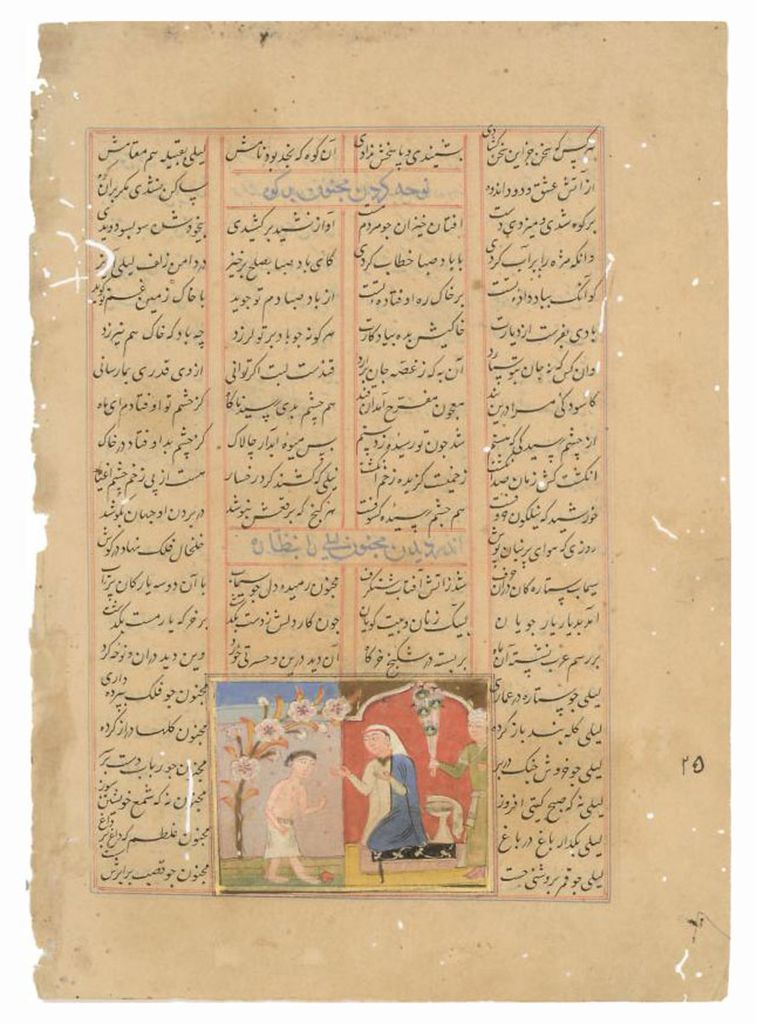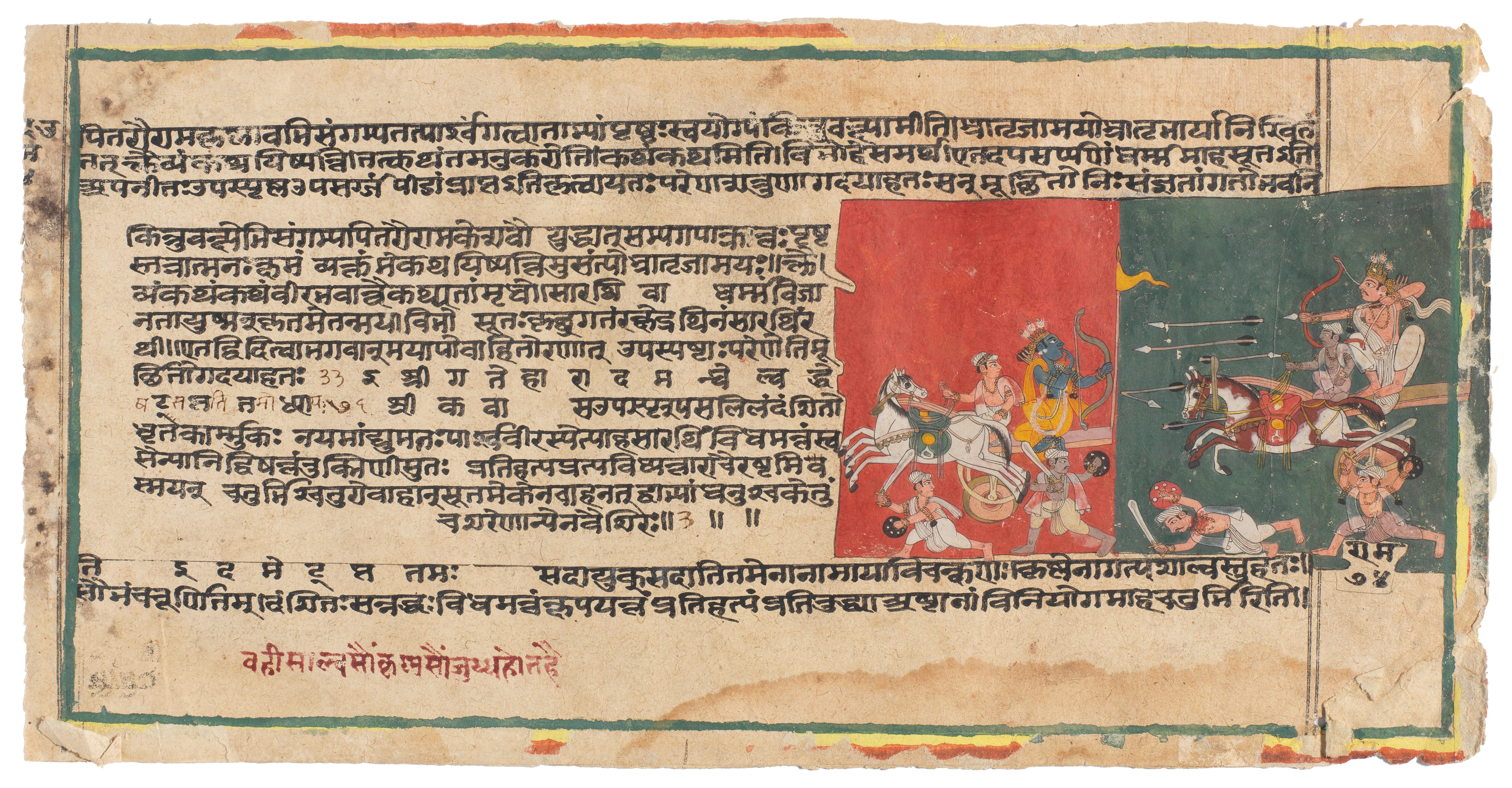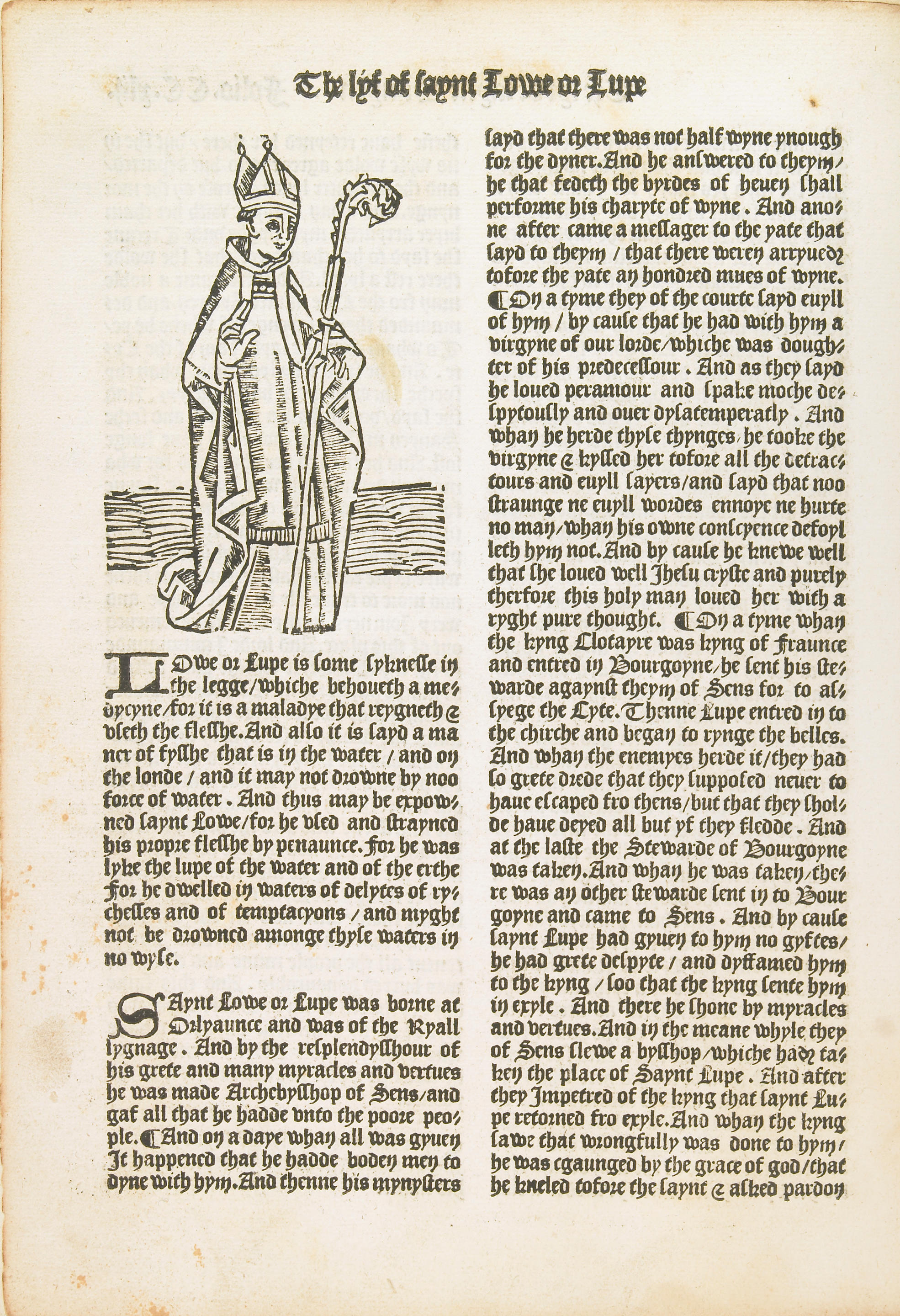An illustrated leaf (folio 70) from a dispersed manuscript of the Virata Parvan (Book 4) of the Mahabharata, depicting Arjuna and Uttara recovering the stolen cows South India, late 17th Centurygouache and gold and nagari manuscript on paper, text written in 12 lines (recto) and 11 lines (verso) in black ink, margins ruled in red painting 110 x 154 mm.; leaf 204 x 492 mm.FootnotesThe colophon of the manuscript, produced in Maharashtra (perhaps in Chalisgaon, not far from Aurangabad) is dated to samvat 1592/AD 1669–70. The place of production is given, as well as the patron, a certain Timaji Pandit, a Brahmin who is also depicted on one leaf. The paintings were added between 1680 and 1690, probably at Tirupati. The figures are depicted in the same idiosyncratic style, squat with heavy and muscular limbs and torsos, heavy modelling of drapery, and very large eyes. This style was previously thought to be that of Mysore. However, more recently, comparison has been drawn with the style of the leather shadow puppets of north-eastern Karnataka and Andhra Pradesh (see A. Dallapiccola, South Indian Paintings: a catalogue of the British Museum collections, London 2010, pp. 16-17); and others have proposed that the pilgrimage centre of Tirupati should be their point of origin (R. Crill, 'Three South Indian Manuscript Paintings in the Victoria and Albert Museum', in A. Dallapiccola (ed.), Indian Painting: the lesser-known traditions, Delhi 2011, pp. 156-71). Maharashtra, further to the north, uses nagari script (as opposed to Telugu, further south), which lends further weight to Chalisgaon as a place of origin. In addition, the patron, Timaji, has a Maratha name. It is conceivable that the manuscript made its way south during the campaigns of Sivaji in the Carnatic (1677-78), passing Tirupati and Madras. The paintings would perhaps therefore have been added later than the text, at this point, at Tirupati. Maratha influence in the south continued until the eclipse of their power in the 19th Century. Other leaves from this text of the Mahabharata are in (inter alia) the National Museum of India, Delhi (see Crill, op. cit., fig. 10); the Victoria and Albert Museum, London (Crill, fig. 10); the Gulbenkian Museum, Durham, NC; The Brooklyn Museum; the Virginia Museum of Fine Arts; the San Diego Museum of Art; the Los Angeles County Museum of Art; and the Jagdish and Kamla Mittal Museum, Hyderabad. For an example at auction, see Sotheby's, Important Indian Miniatures from the Paul F. Walter Collection, New York, 14th November 2002, lot 93. The leaf and its illustration depict a moment from the Virata Parvan (canto 62), the fourth book, of the great epic, the Mahabharata, whose theme is the war between the Pandavas and their cousins, the Kauravas. The Pandavas have finished their twelve years in exile (the result of losing at dice to their cousins), but have to remain in disguise, spending the first year after their return at the court of Virata, king of the Matsyas. The king's cattle are stolen by the Kauravas, and Uttara (son of Virata) pursues them, accompanied by Arjuna (in disguise) as his charioteer. Arjuna defeats the Kauravas, and grants clemency to some of the soldiers, who beg for mercy. He (in disguise) and Uttara then return with the cattle. Two inscriptions above the painting read etah gavah, 'these are the cows', and the name Uttara.
An illustrated leaf (folio 70) from a dispersed manuscript of the Virata Parvan (Book 4) of the Mahabharata, depicting Arjuna and Uttara recovering the stolen cows South India, late 17th Centurygouache and gold and nagari manuscript on paper, text written in 12 lines (recto) and 11 lines (verso) in black ink, margins ruled in red painting 110 x 154 mm.; leaf 204 x 492 mm.FootnotesThe colophon of the manuscript, produced in Maharashtra (perhaps in Chalisgaon, not far from Aurangabad) is dated to samvat 1592/AD 1669–70. The place of production is given, as well as the patron, a certain Timaji Pandit, a Brahmin who is also depicted on one leaf. The paintings were added between 1680 and 1690, probably at Tirupati. The figures are depicted in the same idiosyncratic style, squat with heavy and muscular limbs and torsos, heavy modelling of drapery, and very large eyes. This style was previously thought to be that of Mysore. However, more recently, comparison has been drawn with the style of the leather shadow puppets of north-eastern Karnataka and Andhra Pradesh (see A. Dallapiccola, South Indian Paintings: a catalogue of the British Museum collections, London 2010, pp. 16-17); and others have proposed that the pilgrimage centre of Tirupati should be their point of origin (R. Crill, 'Three South Indian Manuscript Paintings in the Victoria and Albert Museum', in A. Dallapiccola (ed.), Indian Painting: the lesser-known traditions, Delhi 2011, pp. 156-71). Maharashtra, further to the north, uses nagari script (as opposed to Telugu, further south), which lends further weight to Chalisgaon as a place of origin. In addition, the patron, Timaji, has a Maratha name. It is conceivable that the manuscript made its way south during the campaigns of Sivaji in the Carnatic (1677-78), passing Tirupati and Madras. The paintings would perhaps therefore have been added later than the text, at this point, at Tirupati. Maratha influence in the south continued until the eclipse of their power in the 19th Century. Other leaves from this text of the Mahabharata are in (inter alia) the National Museum of India, Delhi (see Crill, op. cit., fig. 10); the Victoria and Albert Museum, London (Crill, fig. 10); the Gulbenkian Museum, Durham, NC; The Brooklyn Museum; the Virginia Museum of Fine Arts; the San Diego Museum of Art; the Los Angeles County Museum of Art; and the Jagdish and Kamla Mittal Museum, Hyderabad. For an example at auction, see Sotheby's, Important Indian Miniatures from the Paul F. Walter Collection, New York, 14th November 2002, lot 93. The leaf and its illustration depict a moment from the Virata Parvan (canto 62), the fourth book, of the great epic, the Mahabharata, whose theme is the war between the Pandavas and their cousins, the Kauravas. The Pandavas have finished their twelve years in exile (the result of losing at dice to their cousins), but have to remain in disguise, spending the first year after their return at the court of Virata, king of the Matsyas. The king's cattle are stolen by the Kauravas, and Uttara (son of Virata) pursues them, accompanied by Arjuna (in disguise) as his charioteer. Arjuna defeats the Kauravas, and grants clemency to some of the soldiers, who beg for mercy. He (in disguise) and Uttara then return with the cattle. Two inscriptions above the painting read etah gavah, 'these are the cows', and the name Uttara.







.jpg)






Try LotSearch and its premium features for 7 days - without any costs!
Be notified automatically about new items in upcoming auctions.
Create an alert